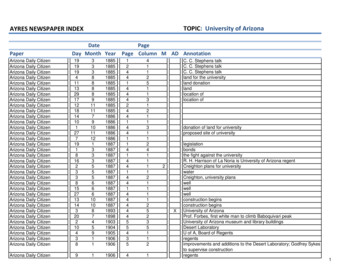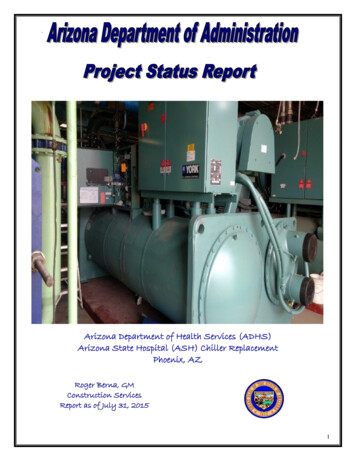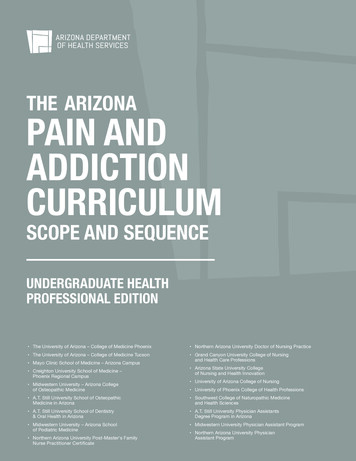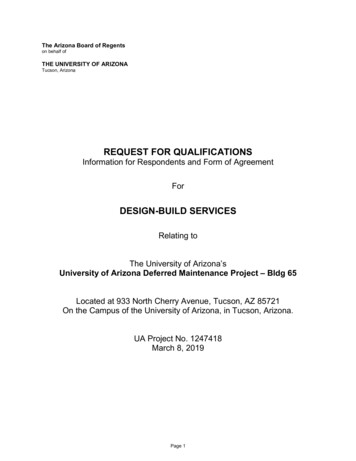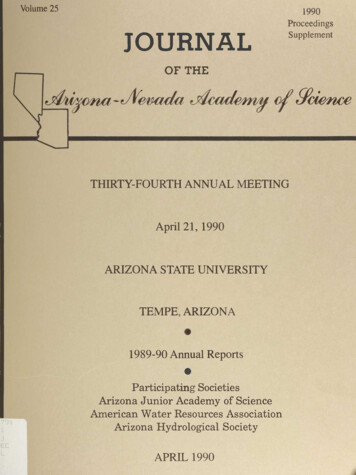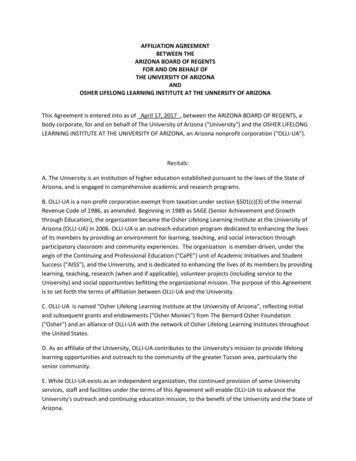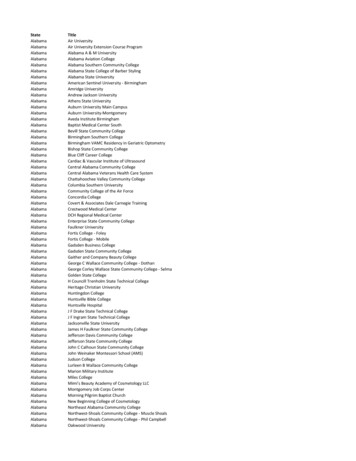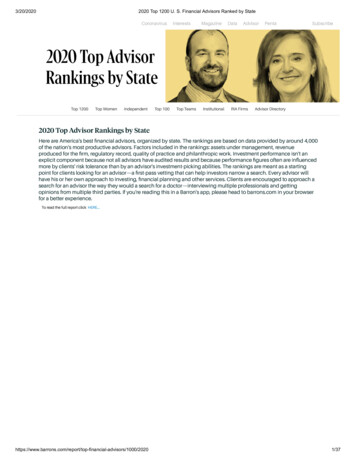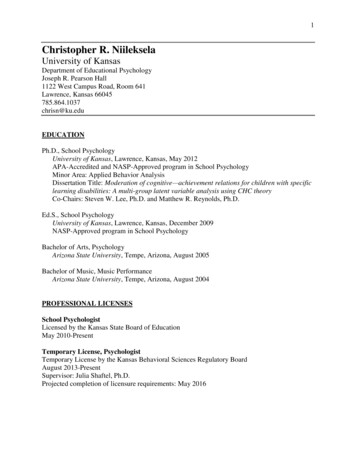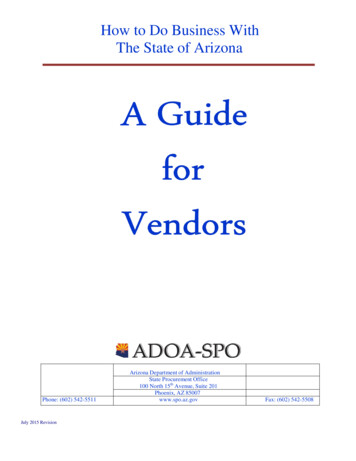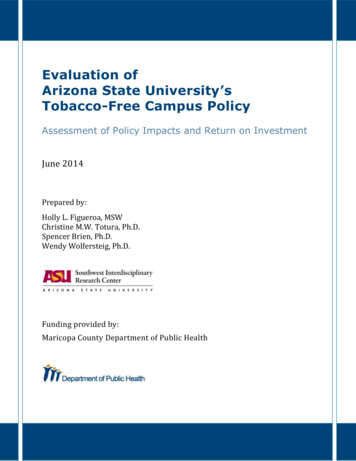
Transcription
Evaluation ofArizona State University’sTobacco-Free Campus PolicyAssessment of Policy Impacts and Return on InvestmentJune 2014Prepared by:Holly L. Figueroa, MSWChristine M.W. Totura, Ph.D.Spencer Brien, Ph.D.Wendy Wolfersteig, Ph.D.Funding provided by:Maricopa County Department of Public Health
AcknowledgementsIn addition to the Maricopa County Department of Public Health, SIRC researchers would like tothank the following individuals, listed alphabetically, for their contributions to this report: Jillian McManus, Director, Organizational Health & Development, ASUKaren Moses, Director, Wellness & Health Promotion, ASUElizabeth Phillips, University Provost & Executive Vice President, ASUKevin Salcido, Associate Vice President and Chief Human Resource Officer, ASUWithout the information these individuals provided and their assistance with survey development,distribution and data collection, this project would not have been possible. Thank you.ii P a g eASU-SIRC, Tobacco-Free Policy
Table of ContentsExecutive Summary1Background6Methodology7Assessment Findings10ASU Faculty/Staff Survey10ASU Student Survey17ASU Student Qualitative Questionnaire22ASU Staff Focus Group24Tobacco-related Litter in the ASU Environment27Return on Investment28Study Conclusions32Next Steps33References34Appendix A: Tobacco-related Litter Counts by Date, Time, and Campus35Appendix B: Returns on Public Health Investments: Policy Impacts on QuittingBehavior and Tobacco Use Deterrence39iii P a g eASU-SIRC, Tobacco-Free Policy
Executive SummaryThe Maricopa County Department of Public Health (MCDPH) and the Southwest InterdisciplinaryResearch Center (SIRC) at Arizona State University (ASU) initiated an evaluation of ASU’s TobaccoFree Campus policy, which went into effect on August 1, 2013. The purpose of this evaluation wasto assess the impacts of this policy on the ASU community and environment. This reportsummarizes tobacco consumption patterns, norms and perceptions surrounding tobacco use,tobacco litter on campus, and overall benefits of a tobacco-free campus both before and after policyimplementation.MethodologyIn order to provide a comprehensive assessment of tobacco use at Arizona State University (ASU)and its associated health and financial costs in advance of the implementation of the tobacco-freecampus policy, data were collected on a multitude of process, outcome, and cost measures. Datacollection methods included: ASU Faculty and Staff SurveyIn 2013, this survey was distributed to all 8,960 benefits-eligible faculty and staff at ASU.More than 3,200 respondents completed the survey for a response rate of 36 percent. In2014, the post-policy implementation survey was distributed to 8,413 benefits-eligibleemployees, resulting in a response rate of 37.4 percent (n 3,147). ASU Student SurveyIn the Spring of 2013, the National College Health Assessment (NCHA-II), includingsupplemental questions in support of the tobacco-free campus evaluation, was distributedto a random sample of 20,000 ASU graduate and undergraduate students; it was completedby 1,547 students (a response rate of 7.7%). In 2014, an online post-policy implementationsurvey was distributed independent of the NCHA-II to another random sample of 20,000students, resulting in a response rate of 18.6 percent (n 3,728). ASU Student Qualitative QuestionnaireIn order to further evaluate attitudes, opinions, and expectations related to the tobacco-freecampus policy, an online questionnaire was administered to all students who reportedcurrent tobacco use on the 2014 survey and a willingness to participate in a follow-upassessment (N 718). This questionnaire resulted in a response rate of 30.8 percent (n 221). Focus GroupsTwo focus groups were conducted for this evaluation, one with eight members of the ASUgroundskeeping crew on the Tempe campus and a second with six staff members from theTempe campus who currently use tobacco products and were willing to participate infollow-up assessment activities following the online survey. The groundskeepers providedinformation on perceived policy impacts with respect to tobacco-related litter and thecleanliness of campuses. The staff focus group (response rate 27.3%, n 6) furtherinvestigated attitudes, opinions, and expectations related to the tobacco-free campus policy.1 PageASU-SIRC, Tobacco-Free Policy
Tobacco-related Litter in the ASU EnvironmentSIRC researchers and students conducted a manual tally of tobacco-related litter (e.g.,cigarette butts, cigarette and cigar wrappers, lighters, matchbooks, etc.) across several ASUcampuses at three different time points: Spring 2013, Fall 2013, and Spring 2014.Additional data and information were collected via informal and unstructured one-on-one andgroup interviews, emails and phone conversations with key staff and student informants at ASU.Assessment HighlightsASU Faculty/Staff Survey The percentage of respondents who were aware of the tobacco-free campus policy grew to97.5 percent. The level of support for the policy increased from 80.5 percent in 2013 to 85.3percent in 2014. Roughly seven percent of ASU faculty and staff reported currently smoking cigarettes in2013 and 2014; approximately five percent currently used other tobacco products in 2013with this percentage decreasing to approximately 4 percent in 2014. A smaller percentage of current (past 30 days) or recent (past 12 months, but not in last 30days) smokers reported excellent or very good health than those who have not smokedwithin the last 12 months, particularly among the 2014 sample. There was a 48.8 percent reduction in the amount of secondhand smoke respondentsreported being exposed to on campuses between 2013 and 2014. Respondents reported a 27.4 percent reduction in frequent reports of tobacco-related litterbetween 2013 and 2014. The majority of staff and faculty reported that the tobacco-free campus policy either greatlyor somewhat reduced the amount of tobacco-related litter (61.9%) and secondhand smoke(61.6%) they are exposed to on campus. The majority of respondents believed that ASU campuses should remain 100 percenttobacco-free. The most frequently endorsed policy enforcement method was to givewarnings to violators of the policy, followed by issuing a small fine.ASU Student Survey In the Spring of 2014, 88.5 percent of respondents were aware of ASU’s tobacco-freecampus policy. The majority of these respondents also believed that the policy wasadequately communicated (59.5%). More than eight in ten students (81.2%) reported supporting the tobacco-free campuspolicy in 2014. This is about a 3 percent increase in support from 2013. Approximately 14.7 percent of ASU students were current cigarette smokers in 2013 and13.3 percent were current smokers in 2014, indicating a 9.5 percent reduction in use.However, current use of smokeless tobacco, hookah, and e-cigarettes increased.2 PageASU-SIRC, Tobacco-Free Policy
By 2014, the proportion of students reporting frequent exposure to secondhand smoke wasnearly cut in half. Furthermore, there was a 20.8 percent decrease in the amount oftobacco-related litter observed following- policy implementation. By 2014, slightly more than 18 percent of student tobacco users felt that the policy had aninfluence on their quitting. More than half of student respondents attributed reductions in secondhand smoke (54.6%)and tobacco-related litter (53.6%) on campus to the policy. The majority of respondents believed that ASU campuses should remain 100% tobaccofree. However much like staff and faculty, a large proportion of respondents felt that thereshould be designated smoking areas on campus to accommodate tobacco users. As with the faculty/staff survey, the most frequently selected policy enforcement techniquewas to give warnings to violators of the policy, followed by issuing a small fine andreporting the violator to student conduct or a supervisor.Student Qualitative Questionnaire Many students, mostly non-users, reported that the overall campus environment hadimproved as a result of the policy. They believed that campuses were cleaner and that thepolicy resulted in fewer smokers and secondhand smoke. However, both users and nonusers acknowledged that the policy likely just shifted where people smoke, such as behindbuildings and in stairwells. Tobacco users, however, felt that the largest impact of the policy was that it led to a lessfriendly campus characterized by more interpersonal conflict. Smokers reported feeling“harassed.” Respondents reported concerns about policy enforcement and suggested implementingdesignated smoking areas as a solution to noncompliance.Staff Focus Groups Participants liked that the tobacco-free campus policy was a good influence on health andsmoking habits. They believed that it encouraged smokers to take fewer breaks and tosmoke less on campus as the policy makes smoking less convenient and less sociallyaccepted among college students. Participants also reported appreciating that campuses were generally cleaner and freshersmelling. Participants believed that the policy had a limited effect on encouraging smokers to quit andthat it had no impact in their off-campus behavior. Respondents reported concerns about policy enforcement and that the soft, or peer,enforcement invites interpersonal conflict among staff and students. A recommendedsolution was to designate authorized individuals to deter smoking though visual cues. Staff also believed that the policy may have shifted where people smoke and that it ishappening in more hidden areas where tobacco-related litter has been accumulating. Asuggested policy solution is to designate specific smoking areas on campuses.3 PageASU-SIRC, Tobacco-Free Policy
Tobacco-related Litter in the ASU Environment Cigarette butts made up the vast majority of tobacco-related litter and were most commonlyfound in the garden strips between sidewalks and public streets, on the edges of sidewalks(especially those along public streets), in flower beds, and in the grates surrounding trees. Policy implementation may have had an influence on smoking behavior, and therefore theamount of smoking-related litter. Litter counts on each campus generally declined acrosseach data collection point, anywhere from 32 percent to 82 percent. Some of the largest percent decreases were noted on the Downtown campus, in particulararound Taylor Place and on the Taylor Mall.Summary of the Return on Investment (ROI) AnalysisThe strategy employed to estimate the return on investment associated with the tobacco-freecampus policy focused on health benefits and reduced healthcare costs generated by the policy. TheROI assessment found the following: Benefits of the Tobacco-Free Campus Policy exceed the costs. Using the proportion of smokers that had quit for 30 days, the 2013 staff and faculty surveyrespondents had a quit rate of 35.9 percent while the 2014 respondents had a quit rate of34.6 percent. A significant shift in smoking rates was not observed among students following theimplementation of the tobacco-free campus policy. When comparing student survey respondents who started smoking after coming to ASU, butwho have not smoked in the last 30 days, there is a statistically significant drop from 11.4percent to 5.6 percent from 2013 to 2014. Applying this percentage to the overall studentpopulation suggests that as many as 4,200 fewer students may have tried smoking for thefirst time while at ASU in the year following the implementation of the tobacco-free campuspolicy. Assuming that 25 percent of the 4,200 student smokers who were deterred from tryingcigarettes for the first time eventually became heavy smokers, then they would each haveultimately incurred the 229,837 in social costs associated with a lifetime of smoking. Thiswould result in an aggregate present value cost of 241,328,850. Given that the entire costs of implementing the program totaled roughly 80,000, thelifetime return on investment of this policy for just one person would be 280 percent. These evaluation results do not indicate any significant cost savings to ASU due to changesin faculty and staff tobacco use that can be attributed to the tobacco ban.4 PageASU-SIRC, Tobacco-Free Policy
Conclusions In general, survey results demonstrated that the majority of students, staff, and facultysupported a tobacco-free campus, and a smaller proportion of smokers indicated that thepolicy had some influence in reducing their tobacco use. Furthermore, significantreductions in perceived levels of tobacco-related litter and secondhand smoke werereported following implementation of the policy. Survey data revealed that at this point the most visible change in actual smoking behaviorthat coincides with ASU’s adoption of the policy was a significant reduction in studentstrying cigarettes for the first time following their enrollment in ASU. The lifetime cost savings in deterring new, regular smokers would justify adoption of thepolicy. Concerns remain related to compliance and soft enforcement methods for the policy. Manyrespondents feel stronger methods, such as the involvement of authorized ASU personnel inissuing warnings or fines, would be more effective.5 PageASU-SIRC, Tobacco-Free Policy
Evaluation of Arizona State University’sTobacco-Free Campus PolicyAssessment of Policy Impacts and Return on Investment EstimatesBackgroundTobacco use remains the leading cause of preventable death in the United States (Koh, 2012).1 Toaddress this nationwide public health issue, many states and organizations have begun toimplement various tobacco control programs. Given today’s widespread recognition that tobaccouse is a public health hazard along with convincing research findings that showed the associationsbetween tobacco control policies and decreased tobacco use and tobacco-related healthconsequences, many colleges and universities have recently begun to implement their own tobaccocontrol policies. The American College Health Association Guidelines, last updated in November2011, now advocate for a campus-wide tobacco-free environment. The first tobacco-free collegecampus policy was established as recently as the early 2000s. There are now more than 750 collegecampuses nationwide that have gone 100 percent tobacco-free, and nearly 400 more that have gonesmoke-free (American Nonsmokers’ Rights Foundation, November 2013), which clearly illustratesthe popularity of tobacco-free policy uptake among U.S. colleges and universities.Alignment with Healthy People 2020 GoalsTobacco-free campus policies are directly in line with the Healthy People 2020 goals as well. Thefollowing Healthy People 2020 goals and objectives specifically relate to tobacco use among adultsover 18 and college-aged individuals:1. Reduce tobacco use by adultsa. Reduce cigarette smoking by adults to 12.0 percent.b. Reduce use of smokeless tobacco products by adults to 0.3 percent.c. Reduce use of cigars by adults to 0.2 percent.2. Reduce the initiation of tobacco use among young adults aged 18 to 25 years by 2percentage pointsa. Reduce the initiation of the use of tobacco products by young adults to 8.8 percent.b. Reduce the initiation of the use of cigarettes by young adults to 6.3 percent.c. Reduce the initiation of the use of smokeless tobacco products by young adults to0.2 percent.d. Reduce the initiation of the use of cigars by young adults to 4.1 percent.3. Reduce the proportion of nonsmokers exposed to secondhand smoke by 10 percent.Refer to the 2013 Evaluation of Arizona State University’s Tobacco-Free Campus Policy report for a full review oftobacco-related research and statewide initiatives.16 PageASU-SIRC, Tobacco-Free Policy
ASU’s Tobacco-Free PolicyThe Arizona State University (ASU) tobacco-free campaign began in 2009 by a student organizationcalled Health and Counseling Student Action Committee (HCSAC). From 2009 to the adoption of atobacco-free campus policy on November 15, 2012, HCSAC advocated for this policy throughpetitions, articles in local newspapers, student action letters sent directly to ASU President, MichaelCrow, and through various tobacco awareness events held on ASU campuses. In the process, HCSACgained key supporters including Undergraduate Student Government (USG) in late 2010, whichreleased position statements supporting increased smoking regulations, and the faculty AcademicSenate in late 2012, which ultimately approved the proposed tobacco-free policy.The ASU tobacco-free campus policy (ACD 804: Tobacco-Free Campus) went into effect on August1, 2013 and states:To protect the health and safety of university faculty, staff, students, and visitors on thecampuses of ASU Smoking and the use of smokeless tobacco products are prohibited in or onall university:1.2.3.4.5.6.Owned propertyLeased propertyFacilitiesGroundsParking structuresUniversity-owned vehiclesSince tobacco-free campus policies such as this one are relatively new, evidence of their impactremains sparse. Thus, in order to assess the effectiveness of ASU’s new tobacco-free campus policyas well as its return on investment, comprehensive evaluation was necessary. This evaluationreport compared data on both pre- and post-policy implementation measures.MethodologyIn order to provide a comprehensive assessment of tobacco use at ASU and its associated healthand financial costs in advance of and following the implementation of the tobacco-free campuspolicy, data were collected through multiple methods.ASU Faculty and Staff SurveyIn the Spring of 2013, an online survey was distributed via ASU’s Chief Human Resources Officer toall benefits-eligible faculty and staff (n 8,960) in order to assess tobacco-use on and off-campus,quitting behavior, motivations to quit smoking, and general health prior to implementation of ASU’stobacco-free campus policy. The survey allowed for respondents to skip questions, and the skippattern of the survey allowed only those who responded to certain questions to answer subsequentquestions. More than 3,200 (n 3,239) faculty and staff completed the online survey for an overallresponse rate of 36 percent.In April 2014, a post-policy implementation online survey was distributed to all 8,413 benefitseligible staff and faculty, with a response rate of 37.4 percent (n 3,147). This survey measured7 PageASU-SIRC, Tobacco-Free Policy
tobacco-use, quitting behavior, motivations to quit, and general health again, in addition to opinionsabout the implementation of ASU’s tobacco-free campus policy, barriers to its success, and potentialinfluences on quitting and/or smoking deterrence.Items for both the pre and post-implementation surveys were selected from a variety of nationaland state-level surveys such as the National Survey of Drug Use and Health (NSDUH) and theArizona Health Survey (AHS), as well as from post-surveys conducted at other universities anditems requested by the Maricopa County Department of Public Health.ASU Student SurveyAssessment of student tobacco-use and related behaviors was conducted in parallel to the staff andfaculty assessment process. Online surveys were developed and distributed to a random sample ofstudents in the Spring of 2013 (pre-policy implementation) and in the Spring of 2014 (post-policyimplementation). Administration for both surveys was conducted in coordination with the ASUOffice of Student Wellness, which distributes the National College Health Assessment (NCHA-II) incoordination with the American College Health Association (ACHA) annually to a random sample of20,000 ASU students at the undergraduate and graduate levels.Additional tobacco policy questions were included in ASU’s 2013 NCHA-II survey by SIRCresearchers for the purposes of evaluating the tobacco-free campus policy. However, for the 2014administration, SIRC researchers designed a separate survey from the NCHA-II and distributed it toa random sample of 20,000 students with the assistance of the ASU Office of Student Wellness.In order to encourage participation in the 2013 survey, ASU officials offered participants an entryinto a prize drawing for the opportunity to win one of ten 200 ASU Maroon & Gold gift cards. Toencourage participation in the 2014 survey, researchers offered participants an entry into a prizedrawing for the opportunity to win one of twenty 50 Visa gift cards.The 2013 survey resulted in a response rate of 7.7 percent (n 1,547); 18.6 percent (n 3,728)completed the survey in 2014.Unless otherwise indicated, pre-implementation tobacco usage rates are reported based on studentresponses to the supplemental questions that were added to the 2013 NCHA-II specifically for thepurposes of this study. The standard NCHA-II also includes tobacco use questions; however, thestandard questions are worded slightly differently and reported usage rates were slightly (1-2%)lower for cigarettes and cigars, cigarillos or pipes, and slightly (1.2%) higher for smokeless tobaccoas compared to the reported usage rates for these products on the supplemental questions.However, for both the 2013 and 2014 assessments, student daily consumption was determined bytobacco product usage over the past 30 days from survey administration.ASU Student Qualitative QuestionnaireThe 2014 student survey was followed by an online qualitative questionnaire to investigate furtherthe attitudes, opinions, and expectations for ASU’s tobacco-free campus policy. Specifically,questioning focused on beliefs about policy impact, barriers to implementation, andrecommendations to improve compliance. The questionnaire was administered to all students whoreported current tobacco use on the 2013 student survey and willingness to participate in followup assessment (N 718). The response rate for the questionnaire was 30.8 percent (n 221).8 PageASU-SIRC, Tobacco-Free Policy
Tobacco-related Litter in the ASU EnvironmentA manual tally of tobacco-related litter (e.g., cigarette butts, cigarette and cigar wrappers, lighters,matchbooks, etc.) was conducted on ASU campuses in the Spring and Fall of 2013 and the Spring of2014 to assess policy compliance and changes in litter as a potential result of policyimplementation (Fallin et al., 2012).SIRC researchers mapped out high usage areas of campus as well as boundaries where litter wasexpected. All researchers and students who conducted the manual tallies were given a commontally sheet on which to record their litter observations and were instructed to include in their talliesonly the tobacco-related litter that fell explicitly within the boundaries of ASU’s designated tobaccofree zones. This includes most walkways, buildings, garages and garden areas on campus, but doesnot include most paved streets which fall under the purview of the local governmental agencies ineach city in which an ASU campus is located.Data collectors summed the total observations of tobacco-related litter for each section of campusfor which they were responsible and recorded this information, as well as the date and time thetally was conducted.The following areas on each campus were observed for tobacco-related litter: Downtown University Center and University Center Garage (perimeter and 3rd floor only) Taylor Place (on-campus housing) Taylor Mall (between University Center and the Cronkite Building) Mercado (perimeters and interior walkways between all buildings)Tempe Cady Mall Forest MallWest Verde Mall Verde Dining Pavilion Las Casas Residence Hall Wood DrivePolytechnic (litter count was not conducted in the Spring of 2013)2 Sonoran Arroyo Mall Backus Mall Sun Devil MallFocus GroupsGroundskeeper Focus GroupA focus group was conducted with eight members of the groundskeeping crew on the ASU Tempecampus in order to better understand implications of the tobacco-free campus policy. Specifically,Following an interview with an ASU Facilities representative, researchers decided not to collect litter tally data in thespring of 2013 at the ASU Polytechnic campus. According to this representative, the ASU Polytechnic campus was alreadynearly smoke-free as it has designated smoking areas in place that are the only places individuals may smoke on campus.29 PageASU-SIRC, Tobacco-Free Policy
questions asked about perceptions of policy impact, concerns about tobacco-related litter oncampus, recommendations for policy compliance, and methods of enforcement. All of theparticipants were male non-smokers with an average age of 46.5 years (50% non-Hispanic White,37.5% Hispanic/Latino, 12.5% American Indian/Alaska Native).Staff Focus GroupThe 2014 staff and faculty survey was followed by a focus group to investigate further the attitudes,opinions, and expectations for ASU’s tobacco-free campus policy. Similar to the student qualitativequestionnaire, questioning focused on beliefs about policy impact, barriers to implementation, andrecommendations to improve compliance. Participation in the focus group was offered to all staffand faculty who reported current tobacco use on the 2014 survey and willingness to participate in afollow-up assessment (N 22). Based upon participant availability, the focus group was limited tofaculty and staff at the Tempe campus. The overall response rate for the focus group was 27.3percent (n 6).Assessment FindingsASU Faculty/Staff SurveyThese surveys provided baseline and post-implementation information on the attitudes andbehaviors of the ASU faculty and staff regarding tobacco use and perceptions of the tobacco-freepolicy. Of the 2013 survey respondents, 26 percent self-identified as faculty with 74 percent as staffmembers; this compares to the actual ASU employee percentages of 29 percent faculty and 71percent staff (although a significant portion of staff appear to serve in faculty positions as well). Ofthe 2014 survey respondents, 23 percent self-identified as faculty and 76 percent as staff. OverallASU employee percentages in 2014 were 35 percent faculty and 65 percent staff. Faculty membersappear to be slightly less represented in the 2014 sample than in the 2013 survey sample.Policy Awareness and SupportWhen the 2013 survey was administered, almost all (94%) respondents indicated that they wereaware that ASU would be a tobacco-free campus as of August 1, 2013. Approximately two-thirds ofthem (64.9%) said that there had been adequate communication about the new policy, one-thirdsaid there had not been enough communication, and less than 2% said there had been too muchcommunication.By the Spring of 2014, the percentage of respondents who were aware of the tobacco-free campuspolicy grew to 97.5 percent. Slightly more respondents (66.6%) felt communication about thepolicy was adequate, 28.5 percent felt there was not enough communication, and 4.3 percentbelieved there was too much.The majority (80.5%) of faculty and staff said that they supported the tobacco-free policy in theSpring of 2013. Of those, 62 percent strongly agreed while 15 percent disagreed and five percentwere neutral. By 2014, the level of support increased to 85.3 percent, with 71.1 percent in strongagreement of the policy. Similar to the 2013 survey results, far fewer males were in support of thepolicy (78.8%) than females (90.1%). However, attitudes did not differ by employee role, whetherfaculty or staff.10 P a g eASU-SIRC, Tobacco-Free Policy
Tobacco Use and PerceptionsIn both years, more than eight in ten faculty and staff agreed that smoking cigarettes was perceivednegatively by close friends and colleagues.Respondents who reported using a tobacco product at least once in their lifetime on each surveywere then asked to respond to questions regarding tobacco use behaviors. Those who respondedno to this question skipped the tobacco use behavior questions. Across both years, those whoreported smoking cigarettes in the past 30 days were identified as current users (n 257; Table 1).Table 1. Last Time Used Tobacco.CigarettesOther (including ecigarettes)In the past 30 daysIn the past 12 monthsbut not in the past 30daysSometime in yourlifetime but not in thepast 12 monthsNeverTotalIn the past 30 31297.6%100.0%6.5%In the past 12 monthsbut not in the past 30days1547.2%1708.6%Sometime in yourlifetime but not in thepast 12 132100.0%1177100.0%Note: The numbers listed in this table only include those who reported ever having used tobacco in their lifetime, not theentire sample for each survey. Thus, of the total 2013 survey sample (n 3,239), 7-8% are current cigarette smokers andapproximately 5% are current users of other tobacco products or e-cigarettes. Of the 2014 sample (n 3,147), 7% arecurrent smokers and 4.1% are current users of other tobacco products.A total of 157 respondents from the 2013 survey indicated they had used e-cigarettes or someother tobacco product in the past 30 days; 69 of these were the same people who said that they hadsmoked cigarettes in the past 30 days. Thus, the total of 345 current tobacco product users(257 157-69) representied approximately 10 percent of the sample of 3,239 faculty and staff.Among the 2014 respondents, 58 reported both cigarette and other tobacco product usage(including e-cigarettes) in the last 30 days. Therefore, the 290 current users in 2014 represent 9.2percent of the total staff and faculty sample.Health and ProductivityWhen asked about their general health, more than 90 percent of 2013 survey respondents said theyhad good to excellent health: one-fourth (24.9%) said their health was excellent, nearly half (46.2%)said their health was very good, with 24.4 percent claiming to have good health. There was asignificant difference (p .05) between faculty and staff responses on this question, with 37.5percent of faculty compared to 20.6 percent of staff indicating that their health was excellent.11 P a g eASU-SIRC, Tobacco-F
1 P a g e ASU- S I R C , T o b a c c o - F r e e P o l i c y Executive Summary The Maricopa County Department of Public Health (MCDPH) and the Southwest Interdisciplinary Research Center (SIRC) at Arizona State University (ASU) initiated an evaluation of ASU's Tobacco-Free Campus policy, which went into effect on August 1, 2013.
